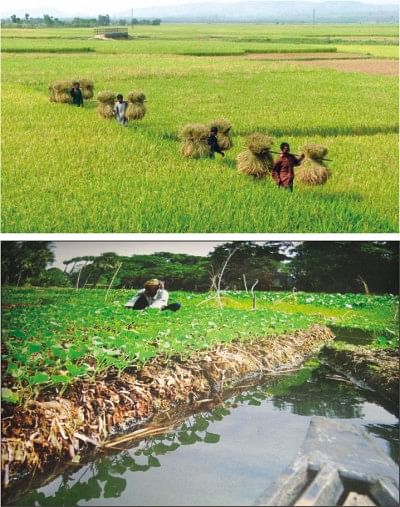Adapting agriculture to climate change

Floating vegetable cultivation on water hyacinth mass.
Climate change the ultimate global warming impact due to green house effect is changing most of our traditional agricultural practices as the seasonal cycle and rainfall pattern have changed, droughts have become more frequent, violent stresses of natural disasters like cyclones, earth quakes, prolonged floods, salt water intrusions are increasing day by day. The average temperature has increased in the summer while winter season has shortened. There are some projections about climate change that are matter of concern for Bangladesh as such: temperature would rise 1.30 C by 2030 and 2.60 C by 2070, the sea level rise would be up by three feet and a greater part of the costal area would be inundated.
As a consequence 17 percent of total cultivable land would be affected. Three crore of people would lose their farms and homesteads. Threatening the richest and most productive region of the country, sea level rise could have dramatic consequences for its economy. Increased flooding from glacial melt, more intense monsoons, or more intense cyclones could also adversely affect agriculture in near term, periodically inundating much agricultural land. Sea level rise under climate change would also result in saline intrusion into the river system, which would enhance the backwater effect. Several hundred thousand tons of grain production could be lost as a result of increased salinization from sea level rise.
The Global Climate Risk Index 2009 showed Bangladesh as the most vulnerable nation to extreme weather events as a result of climate change. World Resources Institute (WRI) said, “impacts of climate variability and change cause an additional risk for agriculture”. Moreover, agricultural production is already under pressure from increasing demands for food. In this regard, the present piece of task has been taken to find out the possible alternatives of agricultural inputs to ensure the expected yield of agricultural crops.
Land management: Our cultivable land is decreasing day by day due to uncontrolled population growth, unplanned industrialization, quick urbanization and establishment of different institutions, hat-bazars and the rate of reduction is approximately 1% per year. Moreover, 17 percent of total cultivable land may be affected by sea level rise due to climate change by 2050. Therefore, cultivable fallow land must be brought under cultivation. Irrigation facility must be ensured for all cultivable lands. Without acceptable reason establishment of any infrastructure on cultivable land must be prohibited. Cropping intensity will have to be increased to ensure judicious use of land maintaining soil productivity. For this purpose, appropriate crop rotation and cropping pattern should be followed; multiple cropping and crop diversification practices should be increased. Multilayer cultivation technology in homestead garden should be strengthened. Roof Garden for fruit, flower and vegetable cultivation may be another option. Mushroom may be cultivated inside or outside of the residence. Floating vegetable cultivation on water hyacinth mass (heap) may be practiced in low lying areas which for major part of the year remains submerged.
Irrigation management: The continued trend of more frequent and intense droughts and variations in rainfall due to climate change may have significant impacts on agriculture. The rate of depletion of groundwater is increasing day by day. Production of boro rice and winter vegetables by natural water or surface water is being affected on regular basis. Rain fed agriculture (specially aus and aman rice) mostly changes into irrigated agriculture. So, we must have the provision of irrigation throughout the year. Some possible strategies for managing climate variability and droughts are:
i) retention of rainwater in mini pond or in 9´x6´x3´size pit at any corner of the land to provide supplemental irrigation.
ii) moisture conservation through mulching by straw, water hyacinth, rice husk, polythene etc
iii) government supported practices such as deep tube well and shallow tube well facilitated irrigation with subsidy in fuel and electricity.
iv) introducing early maturity, short duration, and droughttolerant crop varieties
v) following AWD (Alternate Wetting and Drying) method for rice cultivation
vi) using high amount of organic manure to increase water holding capacity of soil.
Vii) alternative adaptation practices such as integrated crop-livestock-fish farming systems, multiple cropping systems, fruit garden on high lands, homestead gardening etc
Fertilizer management: Climate change may change our fertilizer management. Research revealed that an increase of atmospheric carbon dioxide reduces the nitrogen uptake by plants or crops. Moreover, fertilizer management is not same for irrigated agriculture and non-irrigated agriculture. Use of USG (Urea Super Granule) in wetland rice cultivation is a popular method now. But, if water crises arise, this method will not be effective fully. Then, normal urea will have to be used again. So, we should not use USG in drought prone area or in sandy soils. Use of organic manure should increase water-holding capacity of the soil.
Seed or seedling management: Cyclones, storm surges, prolonged floods and droughts may cause serious crop damage any where in Bangladesh. So, provision of extra seeds and seedlings must be there in disaster prone areas so that affected crops could be covered up. During flood floating seedbed, during drought dry seedbed of aus and aman rice may be effective measures. Government should provide improved method of seed processing and storage. Effective farmers training could be arranged for the target group.
Labor management: Due to increase of atmospheric carbon dioxide prevalence of C3 weeds occurs which is more harmful for crops. Moreover, rise in air temperature causes higher incidence of pests. To control higher incidence of pests and weeds more labours are required. But, high cost of labour, lack of skilled labour are major problems in labour management. So, we need to depend on mechanized agriculture more and more that will save time, reduce cost and make operations easy.
Pest management: Pest infestations and diseases of crops are increasing day by day due to global warming. Most of the insect and disease incidences occur due to high temperature and high humidity. Again, lower night temperature with foggy weather and higher day temperature lead to severe blight disease. So, pest and disease tolerant and resistant crop varieties, GM (Genetically Modified) crops with pest tolerant characteristics should be used. Community Agriculture Clinic may be established to identify and control pest and disease attacks.
Appropriate crop/variety selection: Cultivation of existing crops may not be possible following current cropping patterns due to any sudden and tremendous environmental change. Such as wheat cultivation will be impossible if average winter temperature increases by 20 C in Bangladesh. Maize, sweet potato may be the suitable alternatives or any other variety of wheat that can tolerate high temperature. Several lakh tons of grain production could be lost as a result of increased salinization from sea level rise. In this regard, salt tolerant crops or variety should introduced Bangladesh Institute of Nuclear Agriculture Research (BINA) released two salt tolerant aman rice varieties (BINA-8, BINA-9) which showed positive results in last aman season. Bangladesh Rice Research Institute (BRRI) is going to release a salt tolerant rice variety. In case of prolonged flood any variety that can persist for long in submersed condition may be cultivated. BRRI has released two flood tolerant varieties (BRRI dhan 51, BRRIdhan 52) that can sustain at least two weeks of submersed condition. Similarly, drought tolerant crops (jujube, pineapple and other fruits, maize, country bean etc) and tolerant BRRI dhan 42, BRRIdhan 43 and early maturity BRRIdhan 33, BRRIdhan 39, may be cultivated in drought prone areas.
Capital management: Cost of production increases due to abovementioned problems of climate change. So, easy access to agriculture credit is imperative for the affected farmers. Rehabilitation program for severely affected people should be under taken. Subsidy for agricultural inputs may be another option.
Ensuring easy access to information: We should ensure easy access to information for all specially related to production and distribution of agricultural products and inputs. Required information: the reasons of climate change, possible impacts and damages, approximate time of disasters, pest and disease incidences, possible disaster prone areas necessary actions to be taken etc must be provided to the farmers. Effective early forecasting method should be strengthened. Awareness building program for target groups may be taken immediately. Community Radio may be an effective tool for these purposes. Length of agricultural programs must be extended on TV and radio channels. Facilities of ICT or e-agriculture like AICC (Agriculture Information and Communication Centre) should be provided throughout the country for all farmers. Such centres also may be arranged as community agriculture clinic.
Conclusion:Bangladesh is seriously vulnerable to climateinduced hazards although there are so many controversies about the scale of climate change impact. Role of Bangladesh is very limited in this regard. But she will have to suffer and face the tremendous impacts of climate change. There is no panacea to overcome the problems. Therefore, it will be wise for us to adapt ourselves with the changing environment with our limited resources.

 For all latest news, follow The Daily Star's Google News channel.
For all latest news, follow The Daily Star's Google News channel. 



Comments